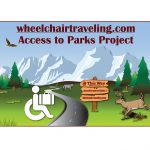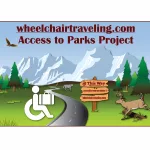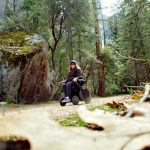Finding and sharing access to parks was always an integral reason for creating wheelchairtraveling.com in 2006. Growing up camping and hiking and then becoming paralyzed, I had to find ways back into nature. Nature is fueling, rejuvenating, and necessary for existence.
It wasn’t long until I realized that very little information on wheelchair access was available online or onsite at the parks. From what I recall, Yellowstone and Yosemite were two of the only national parks that had a well-researched and organized guide of accessible features. Some national park websites had no information at all. Or, I would find a page with only a single sentence about access. More often than not, calling parks or speaking to a park representative onsite would either lead to nowhere or wouldn’t give me the whole picture. Needless to say, I always had more questions than answers.
In every walk with nature, one receives far more than he seeks.– John Muir –
Since no one could thoroughly answer my questions, I decided to find out for myself and then let the world know. From the start of wheelchairtraveling.com, access to the outdoors was important, like national parks as well as monuments, recreational areas, wetlands, landmarks, etc., in addition to state and regional parks and gardens. Along with trails, overlooks, and other points of interest, I also wanted to document basic park features such as toilets and drinking fountains, but also overnight the options (camping, glamping, yurts, bungalows, cabins, and so on). All of these details often varied drastically from park to park, which only fueled the pursuit.
To tell the story of a park’s access, I also created a YouTube Channel, where I continued to add videos, along with the detailed photos in the reviews. As I documented parks, I was grateful to connect with other outdoor lovers using wheelchairs, and some even shared their adventures on my website, to whom I cannot thank enough. Every park ranger that I had the pleasure of meeting, and sometimes interviewing, was lovely and committed to caring for the parks.
With many reviews completed on wheelchairtraveling.com, the National Park Service supported the mission, which aligned with the official creation and launch of the Access 2 Parks Project in 2015. By turning parks into a focal point on wheelchairtraveling.com, I felt more traction, awareness, and support could be gained regarding the need for information on park accessibility.
Perhaps the most important element of the Access 2 Parks Project is the official report with some of the best findings and examples on what does and does not make a park accessible; different examples for different parks and budgets. From website navigation and park maps to trail details and basic park features, the Access 2 Parks Project Official Report is the ultimate guide and the first of its kind to ever be created in history that promotes accessibility in parks for generations to come.
Everybody needs beauty as well as bread, places to play in and pray in, where nature may heal and give strength to body and soul.– John Muir –






